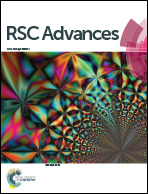Low temperature grown ZnO:Ga films with predominant c-axis orientation in wurtzite structure demonstrating high conductance, transmittance and photoluminescence
Abstract
The Ga doped ZnO films grown at a low substrate temperature ∼50 °C and a low RF power ∼50 W in RF magnetron sputtering possess a predominant c-axis orientation in wurtzite structure with I〈002〉/I〈101〉 ∼ 40 in the XRD pattern; which has been further supported by the most prominent presence of the allowed Raman active A1 (LO) mode. The reduced oxygen vacancies in the ZnO network has been correlated to the enhanced optical transparency while the sharp increase in the presence of metallic Ga in the network identified from the XPS data has been attributed to the increasing electrical conductivity of the films prepared at lower temperature. Associated UV luminescence arises as a result of the typical exciton emission or near-band-edge emission, i.e., due to recombination of photo-generated electrons with holes in the valence band or in traps near the valence band. Highly conducting and optically transparent ZnO:Ga films with a dominant c-axis orientation, demonstrating intense UV-luminescence, are extremely useful for many optoelectronic devices including in solar cells, particularly when prepared at such a low substrate temperature which is most compatible for their fabrication.


 Please wait while we load your content...
Please wait while we load your content...